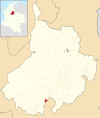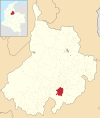Guane people
 Guane doubled-chambered, ceramic, stirrup-spout vessel, 10th–16th century CE, exhibited at Chicamocha National Park | |
| Regions with significant populations | |
|---|---|
| Santander, Boyacá, | |
| Languages | |
| Chibcha, Colombian Spanish | |
| Religion | |
| Traditional religion, Roman Catholicism | |
| Related ethnic groups | |
| Lache, U'wa, Muisca, Muzo, Yarigui |

The Guane were a South American people that lived mainly in the area of Santander and north of Boyacá, both departments of present-day central-Colombia. They were farmers cultivating cotton, pineapple and other crops, and skilled artisans working in cotton textiles. The Guane lived north of the Chicamocha River, around the Chicamocha Canyon in an area stretching from Vélez in the south to the capital of Santander; Bucaramanga in the north.[1] Other sources state their territory did not extend so far north.[2] Guane, a corregimiento of Barichara, Santander, is said to have been the capital of the Guane people.
Etymology
[edit]The word guane in the Chibcha language of the people means "tree" or "lower part of a leaf", or "skirt".[3][4]
Description
[edit]The Guane made their own weapons, including arrows and spears. They interchanged plants for the stewpot with the Chitarero on the east and the Muisca to the south of their territories. The mantle making of the Guanes was well known in pre-Columbian Colombia. Mantles made from cotton have been dated back to the 11th century AD.[5] The Guane cultivated tobacco and made products of fique.[1]
Like the Maya and many other civilizations in the world, the Guane deliberately deformed the skulls of their children.[6]
In 1586, there were still some Guane left but there were no further references found after that date; nevertheless, the local archives indicated that they did not disappear completely. They mixed heavily with the Spanish colonizers, as the Guane were said to have European traits and very light skin.[7]
Like the Muisca, U'wa and Lache, the Guane spoke a Chibchan language.[2] They adored Bochica, the messenger god in the Muisca religion.[8] The Guane traded with their neighbouring indigenous groups; Lache to the east, U'wa to the northeast, Muzo to the south and Muisca to the southeast.[citation needed]
Rock art produced by the Guane have been found around the Chicamocha Canyon and on the Mesa de los Santos, Santander.[8]
The Guane people chewed coca combined with calcitic grains, using poporos.[8]
Municipalities belonging to Guane territory
[edit]The Guane inhabited the area of central and south Santander, around the Chicamocha Canyon and a small part of Boyacá.
| Name | Department | Altitude (m) urban centre |
Map |
|---|---|---|---|
| Guane | Santander | 1336 |  |
| Aratoca | Santander | 1800 |  |
| Cabrera | Santander | 980 |  |
| Coromoro | Santander | 1518 |  |
| Curití | Santander | 1409 |  |
| Encino | Santander | 1850 |  |
| Guapotá | Santander | 1534 |  |
| Güepsa (shared with Muisca and Yarigui) |
Santander | 1540 |  |
| Jordán | Santander | 425 |  |
| Mogotes | Santander | 1700 |  |
| Ocamonte | Santander | 1398 |  |
| Oiba | Santander | 1420 |  |
| Palmar | Santander | 1200 |  |
| Páramo | Santander | 1200 |  |
| Pinchote | Santander | 1131 |  |
| San Gil | Santander | 1117 |  |
| San Joaquín | Santander | 1950 |  |
| Los Santos | Santander | 1310 |  |
| Suaita | Santander | 1700 |  |
| Valle de San José | Santander | 1250 |  |
| Villanueva | Santander | 1450 |  |
| San José de Pare | Boyacá | 1545 |  |
| Santana | Boyacá | 1550 |  |
See also
[edit]References
[edit]- ^ a b (in Spanish) Guane people and their territories
- ^ a b (in Spanish) Reconstruction of the Guane people - El Espectador
- ^ (in Spanish) guane - Chibcha dictionary
- ^ (in Spanish) guane (2) - Chibcha dictionary
- ^ (in Spanish) Guane people and their mantle making Archived 2016-06-11 at the Wayback Machine, colarte.com. Accessed 27 November 2022.
- ^ (in Spanish) Cranial deformation of the Guane and other cultures worldwide, eldoradocolombia.com. Accessed 27 November 2022.
- ^ (in Spanish) Physical aspects of the Guane people, elguane.blogspot.com.co. Accessed 27 November 2022.
- ^ a b c (in Spanish) Description of the Guane people and their culture Archived 2016-07-01 at the Wayback Machine, misteriosconxana.blogspot.com.co. Accessed 27 November 2022.
External links
[edit]- (in Spanish) Video about the Guane people and their culture

